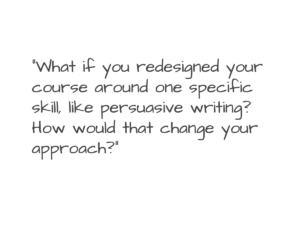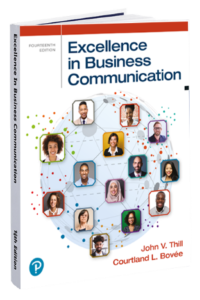Learn here about a powerful, yet simple tool that can unlock "aha moments" for instructors, leading to groundbreaking insights, innovative teaching methods, and fresh perspectives.
As a business communication instructor, you're always eager to create engaging and impactful learning experiences for your students. But the pressure to deliver effective lessons can feel overwhelming. What if there was a simple tool to help you spark those "aha moments" that could inspire new insights, teaching strategies, and innovative approaches?
Breaking Free from Common Barriers
It's natural to rely on familiar methods as an instructor. But this can create barriers to creativity and limit your ability to connect with students in new ways. Here are some common cognitive barriers that instructors often face:
The "Imposter Syndrome": Feeling unsure about your expertise can lead to a fear of trying new things.
The "Content Overload": Feeling pressured to cover everything in the syllabus can lead to rushed lessons and a lack of depth.
The "Linear Thinking": Sticking to a rigid structure can limit your ability to explore creative and interdisciplinary approaches.
The "Fear of Failure": Being afraid to experiment with new teaching strategies can hold you back from discovering your own unique style.
Introducing "Perspective Shift Cards": A Spark for Innovation
To break free from these barriers and discover creative solutions for your teaching, we've developed "Perspective Shift Cards." These simple yet powerful cards are designed to challenge your thinking, inspire fresh ideas, and lead to those "aha moments" that can transform your approach to business communication instruction.
Each card contains a thought-provoking question or scenario that encourages you to view your teaching practices from a new angle. For example:
"Imagine you had to teach this topic without using any technology. How would you engage students?"
"If your students were teaching this course, what would they focus on?"
Perspective Shift Cards: Ignite fresh ideas and unlock innovative teaching breakthroughs.
"What if you redesigned your course around one specific skill, like public speaking? How would that change your approach?"
The Science Behind "Aha" Moments
The effectiveness of "Perspective Shift Cards" is rooted in established psychological and neurological principles:
Cognitive Dissonance: The cards challenge your assumptions, creating dissonance that motivates your brain to seek new perspectives.
Neuroplasticity: The unexpected prompts engage your brain's neuroplasticity, encouraging you to think in new ways and explore creative solutions.
Divergent Thinking: The cards encourage divergent thinking, leading you to consider multiple solutions and approaches. This is crucial for finding innovative solutions to teaching challenges.
Serendipity: The random nature of drawing a card creates a sense of serendipity, allowing your brain to make new connections and stumble upon unexpected insights.
"Perspective Shift Cards" in Action
"Perspective Shift Cards" are usually developed by the instructor or teaching team as a tool to stimulate fresh ideas and overcome cognitive barriers in teaching practices. These cards are crafted to encourage instructors to rethink their approach by presenting unexpected questions or scenarios that push them out of familiar patterns of thinking.
Instructors can create these cards themselves by identifying specific challenges they face or opportunities they want to explore. They might draw on principles from cognitive psychology and neuroplasticity, integrating prompts that challenge assumptions and encourage creative thinking. For instance, they can include questions that focus on limiting resources (e.g., "What if you couldn’t use a particular technology?") or encourage student-centered viewpoints (e.g., "What if your students designed the course?").
How to Create and Use "Perspective Shift Cards"
- Identify Key Barriers: Consider the common barriers instructors face, like imposter syndrome or content overload, and design prompts to address these obstacles.
- Create Diverse Prompts: Develop a range of prompts that encourage divergent thinking, such as
* Constraints-focused prompts: “Teach this concept using only storytelling.”
* Student-led perspective: “If students took the lead, what would they change?”
- Draw on Psychological Insights: Root each card in concepts like cognitive dissonance or serendipity to encourage instructors to push past their comfort zones. These prompts can be powerful tools for inspiring new connections and “aha” moments.
- Integrate in Teaching Routines: Use the cards regularly, such as during lesson planning, post-lesson reflection, or in collaboration with a mentor or peer group, to continually inspire innovation and adapt teaching methods.
Instructors can use these "Perspective Shift Cards" on an as-needed basis to inspire quick creative shifts or embed them into regular planning sessions to keep ideas fresh and instruction dynamic.
Let's say you're feeling stuck in your lectures. You draw a card asking, "How would you teach this concept if you were restricted to only using visuals?" This simple prompt might lead you to incorporate more engaging visual aids, interactive activities, or even short videos into your lessons, sparking new ideas for delivering the content in a more impactful way.
Integrating "Perspective Shift Cards" into Your Teaching
Here are a few ways to use "Perspective Shift Cards" to spark creative breakthroughs in your teaching:
Lesson Planning: Use the cards to challenge your thinking when planning new lessons.
Reflection: After teaching a class or completing a unit, reflect on your experience and use the cards to identify areas for improvement.
Mentorship: If you have a mentor, use the cards together as a tool for exploring new teaching strategies.
Moving Forward:
Embrace the power of "Perspective Shift Cards" to create more dynamic, engaging, and effective learning experiences for your students. You have the opportunity to break free from traditional methods and discover your own unique teaching style. Take the first step towards sparking those "aha moments" and watch your teaching flourish!

Transformative Teaching Made Easy: Unlocking Breakthroughs with Excellence in Business Communication
Excellence in Business Communication is the quintessential resource that business communication instructors should adopt to overcome teaching barriers and inspire breakthroughs in the classroom, much like the transformative "Perspective Shift Cards" highlighted in the recent article. Instructors often grapple with challenges such as imposter syndrome, content overload, linear thinking, and fear of failure. This book directly addresses these issues by offering comprehensive content, innovative teaching strategies, and practical tools that foster both instructor and student engagement.
The book's dynamic approach aligns with the article's emphasis on sparking "aha moments" through fresh perspectives. By integrating real-world examples, interactive exercises, and multidisciplinary case studies, it encourages instructors to move beyond traditional lecture methods. This not only alleviates the pressure of content overload by focusing on depth rather than breadth but also combats linear thinking by promoting creative and interdisciplinary approaches.
Moreover, Excellence in Business Communication provides resources that build instructor confidence, thereby mitigating imposter syndrome. Its step-by-step guides and adaptable lesson plans empower educators to experiment with new teaching strategies without the fear of failure. The book's design inherently creates cognitive dissonance by challenging existing assumptions, which, as the article notes, motivates the brain to seek new perspectives.
By encouraging divergent thinking and leveraging neuroplasticity, the book helps instructors develop innovative solutions to teaching challenges, akin to the benefits of the "Perspective Shift Cards." The inclusion of unexpected prompts and activities introduces an element of Serendipity, enabling both instructors and students to make novel connections and gain deeper insights.
In essence, Excellence in Business Communication serves as a catalyst for educational innovation, making it the ideal choice for instructors aiming to enhance their teaching and inspire their students. Adopting this book will undoubtedly lead to more engaging, effective, and transformative learning experiences.